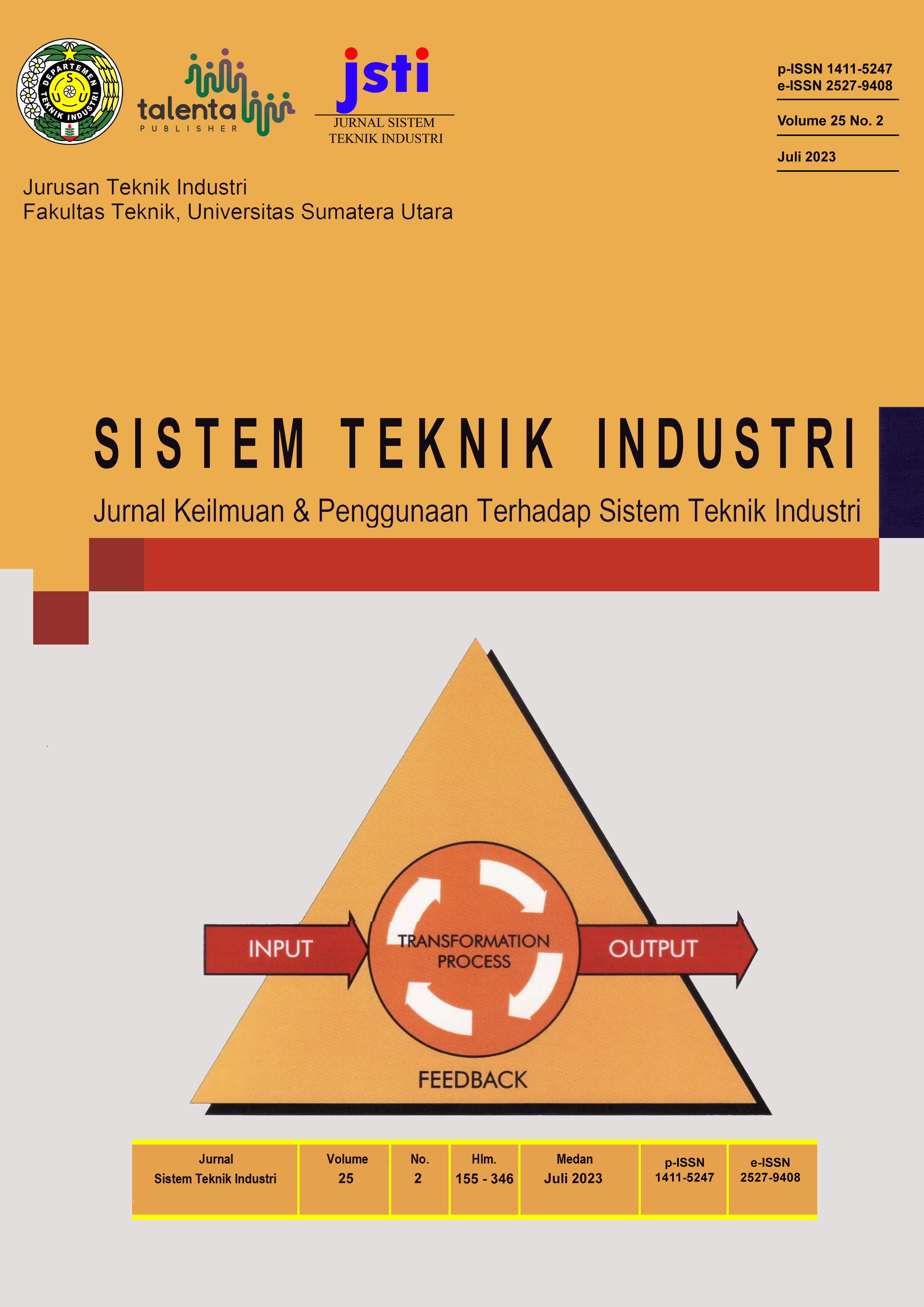Inventory Management Under Uncertainty Condition with Fuzzy Logic: A Literature Review
DOI:
https://doi.org/10.32734/jsti.v25i2.9571Keywords:
Inventory control, Fuzzy Logic, Fuzzy Inference SystemAbstract
Fuzzy set theory, or fuzzy logic, has been in use in inventory systems since the 1980s, with vaguely defined, ill-defined, or imprecise values, or decisions based on individual subjective beliefs. Provides a framework for describing the parameters that can be passed. There are many uncertainties in inventory management that can arise due to many things, such as: Order Changes, Random Supplier Capabilities, or Unexpected Events. Fuzzy logic as a method of inventory control that provides a framework by considering parameters that are vague or poorly defined, or whose values are imprecise and determined based on individual subjective beliefs make it available. The purpose of this white paper is to review previous studies using fuzzy logic in inventory management to see the uncertainty variables used. The method used is a thematic analysis of articles on the application of fuzzy logic in various industries. The results of the review show that variables like fuzzy logic make it easy to obtain results from uncertainty variables that can be applied to industrial activities to enable manufacturing activities to be carried out effectively and efficiently increase.
Downloads
References
S. Ziukov, “A literature review on models of inventory management under uncertainty,†Business Systems & Economics, vol. 5, no. 1, pp. 26–35, Jun. 2015, doi: 10.13165/VSE-15-5-1-03.
S. C. L. Koh and S. M. Saad, “MRP-controlled manufacturing environment disturbed by uncertainty,†2003.
B. Phruksaphanrat, “Fuzzy Inventory Control System for Uncertain Demand and Supply,†2012.
P. Aengchuan and B. Phruksaphanrat, “Inventory system design by fuzzy logic control: A case study,†in Advanced Materials Research, 2013, pp. 619–624. doi: 10.4028/www.scientific.net/AMR.811.619.
Z. Sulistiawan and F. Pribadi, “Studi Perancangan Model Penentuan Jumlah Pemesanan dan Reorder Point Menggunakan Fuzzy Inventory Control Terhadap Nilai Persediaan,†Proceeding Health Architecture, vol. 1, no. 1, 2017.
P. Suryawanshi, P. Dutta, V. L, D. G, and S. J, “Sustainable and resilience planning for the supply chain of online hyperlocal grocery services,†Sustain Prod Consum, vol. 28, pp. 496–518, 2021, doi: 10.1016/j.spc.2021.05.001.
S. M. Regina, “Economic Order Quantity (EOQ) Measurement Using Intelligent Systems Techniques,†2019, Accessed: Jul. 20, 2023. [Online]. Available: https://ourspace.uregina.ca/handle/10294/9203
O. Castillo, P. Melin, J. Kacprzyk, and W. Pedrycz, “Type-2 Fuzzy Logic: Theory and Applications,†p. 145, 2008, doi: 10.1109/GRC.2007.118.
M. Ula, “Implementasi Logika Fuzzy Dalam Optimasi Jumlah Pengadaan Barang Menggunakan Metode Tsukamoto (Studi Kasus : Toko Kain My Text),†Jurnal ECOTIPE, vol. 1, no. 2, 2014.
P. Kovac, D. Rodic, V. Pucovsky, B. Savkovic, and M. Gostimirovic, “Application of fuzzy logic and regression analysis for modeling surface roughness in face milliing,†J Intell Manuf, vol. 24, no. 4, pp. 755–762, 2013, doi: 10.1007/s10845-012-0623-z.
K. Nasrollahzadeh and M. M. Basiri, “Prediction of shear strength of FRP reinforced concrete beams using fuzzy inference system,†Expert Syst Appl, vol. 41, no. 4, Part 1, pp. 1006–1020, 2014, doi: https://doi.org/10.1016/j.eswa.2013.07.045.
H. A. Arı Güner and H. A. Yumuk, “Application of a fuzzy inference system for the prediction of longshore sediment transport,†Applied Ocean Research, vol. 48, pp. 162–175, 2014, doi: https://doi.org/10.1016/j.apor.2014.08.008.
F. Camastra et al., “A fuzzy decision system for genetically modified plant environmental risk assessment using Mamdani inference,†Expert Syst Appl, vol. 42, no. 3, pp. 1710–1716, 2015, doi: https://doi.org/10.1016/j.eswa.2014.09.041.
N. Kocyigit, “Fault and sensor error diagnostic strategies for a vapor compression refrigeration system by using fuzzy inference systems and artificial neural network,†International Journal of Refrigeration, vol. 50, pp. 69–79, Feb. 2015, doi: 10.1016/J.IJREFRIG.2014.10.017.
C. Hsun Hsieh and C.-H. Hsieh, “Optimization of Fuzzy Inventory Models under Fuzzy Demand and Fuzzy Lead Time,†2004. [Online]. Available: https://www.researchgate.net/publication/241886076
E. Khanlarpour, H. Fazlollahtabar, and I. Mahdavi, “Designing an Intelligent Warehouse Based on Genetic Algorithm and Fuzzy Logic for Determining Reorder Point and Order Quantity,†Computer Science and Information Technology, vol. 1, no. 1, pp. 1–8, 2013, doi: 10.13189/csit.2013.010101.
R. Uthayakumar and S. Karuppasamy, “A FUZZY INVENTORY MODEL WITH LOT SIZE DEPENDENT ORDERING COST IN HEALTHCARE INDUSTRIES,†Operations Research and Applications : An International Journal, vol. 3, no. 1, pp. 17–29, Feb. 2016, doi: 10.5121/ORAJ.2016.3102.
A. Abdel-Aleem, M. A. El-Sharief, M. A. Hassan, and M. G. El-Sebaie, “Implementation of fuzzy and adaptive neuro-fuzzy inference systems in optimization of production inventory problem,†Applied Mathematics and Information Sciences, vol. 11, no. 1, pp. 289–298, 2017, doi: 10.18576/AMIS/110135.
R. Jamegh, A. Kassam, and S. Sabih, “Development of Fuzzy Logic Approach to Optimize Safety Level in Deteriorated Products/ a Suplly Chain Dairy Industries Case Study,†Al-Qadisiyah Journal For Enginnering Science. All rights reserved, vol. 11, no. 3, 2018.
R. Jamegh, A. Kassam, and S. Sabih, “Safety Stock Identification in Beverage Soft Drink Industries by Using Dynamic Fuzzy Logic,†Journal of University of Babylon for Engineering Sciences, vol. 26, no. 9, 2018.
I. M. B. W. L. Wibawa, M. R. Satrio, and N. W. S. Ariyani, “Recommendation SystemCooperative Stock Goods Orders Using Fuzzy Tsukamoto,†International Journal of Engineering and Emerging Technology, vol. 3, no. 2, 2018.
G. K. Ramadhan* and D. N. Utama, “Fuzzy Tsukamoto based Decision Support Model for Purchase Decision in Pharmacy Company,†International Journal of Recent Technology and Engineering (IJRTE), vol. 8, no. 4, pp. 3868–3874, 2019, doi: 10.35940/IJRTE.D8243.118419.
M. Ali, R. C. Deo, N. J. Downs, and T. Maraseni, “An ensemble-ANFIS based uncertainty assessment model for forecasting multi-scalar standardized precipitation index,†Atmos Res, vol. 207, pp. 155–180, 2018, doi: 10.1016/J.ATMOSRES.2018.02.024.
Downloads
Published
How to Cite
Issue
Section
License
Copyright (c) 2023 Jurnal Sistem Teknik Industri

This work is licensed under a Creative Commons Attribution-ShareAlike 4.0 International License.
The Authors submitting a manuscript do so on the understanding that if accepted for publication, the copyright of the article shall be assigned to TALENTA Publisher Universitas Sumatera Utara as the publisher of the journal.
Copyright encompasses the rights to reproduce and deliver the article in all forms and media. The reproduction of any part of this journal, its storage in databases, and its transmission by any form or medium will be allowed.



















